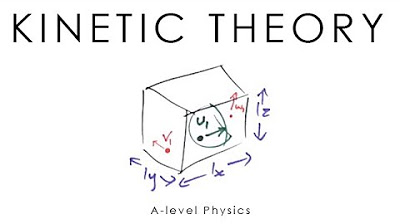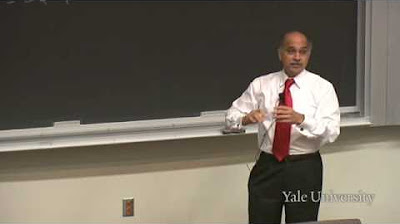Proof: U = (3/2)PV or U = (3/2)nRT | Thermodynamics | Physics | Khan Academy
TLDRThis educational video script delves into the concept of internal energy, particularly focusing on the kinetic energy of particles in an ideal monoatomic gas. It simplifies the complex motion of particles by assuming one-third move along each axis, calculating the pressure exerted by a single particle and then scaling up to the system's total pressure. The script establishes a mathematical relationship between internal energy and macroscopic variables like pressure, volume, and temperature, ultimately deriving the formula for internal energy as 3/2 times the product of pressure and volume, or equivalently, the number of moles, the ideal gas constant, and temperature.
Takeaways
- 🔍 The internal energy (U) of a system includes all forms of energy such as kinetic, potential, chemical, and potential energy of electrons.
- 🌐 For an ideal monoatomic gas, the internal energy is solely the kinetic energy of the particles.
- 📦 The thought experiment involves a cube with particles bouncing off its walls, simulating pressure generation.
- 🧩 The assumption is made that 1/3 of the particles move parallel to each axis, simplifying the calculation of pressure.
- 🚀 The force exerted by a particle on a wall is related to its change in momentum, which is calculated as 2mv for a completely elastic collision.
- ⏱ The time interval between collisions is determined by the distance traveled (2x) divided by the particle's velocity (v).
- 🔄 The pressure exerted by one particle on a wall is derived to be mv^2/x^3, where x is the side length of the cube.
- 🔄 The total pressure on a wall is the pressure from one particle multiplied by the number of particles (N/3) moving in that direction.
- 🌡️ The kinetic energy of a particle is given by mv^2/2, and for the system, it is N times this value, leading to the equation 3/2 pv = Nmv^2/2.
- 🔗 The internal energy of an ideal gas can be expressed as 3/2 nRT, where n is the number of moles, R is the ideal gas constant, and T is the temperature in Kelvin.
- 🔄 Changes in internal energy can be related to changes in temperature or the product of pressure and volume, assuming the number of moles and the ideal gas constant remain constant.
Q & A
What does the symbol 'U' represent in thermodynamics?
-In thermodynamics, the symbol 'U' represents the internal energy of a system, which includes kinetic energy, potential energy of molecules, chemical energy of bonds, and potential energy of electrons.
What is the assumption made about the system in the script when discussing internal energy?
-The script assumes that the system is an ideal gas, specifically a monoatomic ideal gas, where the only energy present is the kinetic energy of the individual atoms.
Why is the kinetic energy of molecules the only energy considered in a monoatomic ideal gas?
-In a monoatomic ideal gas, the molecules consist of single atoms without any chemical bonds or vibrational modes, hence only kinetic energy contributes to the internal energy.
How is pressure related to the motion of particles in the script's thought experiment?
-Pressure is related to the motion of particles as they collide with the walls of the container, exerting force. The script simplifies this by assuming that 1/3 of the particles are moving parallel to each axis, impacting the walls and generating pressure.
What is the formula for force in terms of momentum and time in the context of the script?
-In the script, the formula for force is given by the change in momentum (2mv for a particle bouncing off a wall) divided by the time interval between collisions (2x/v), resulting in force = (2mv) / (2x/v) = mv^2 / x.
What is the relationship between pressure and the kinetic energy of a single particle as derived in the script?
-The script derives that the pressure exerted by a single particle is proportional to the square of its velocity (m v^2) divided by the cube of the container's dimension (x^3), or pressure = m v^2 / V, where V is the volume.
How does the script relate the total pressure on a wall to the number of particles in the system?
-The script states that the total pressure on a wall is the pressure exerted by one particle times the number of particles hitting that wall, which is one-third of the total number of particles (N/3), assuming 1/3 of the particles are moving in each direction.
What is the significance of the formula 3/2 pv = Nmv^2 in the context of the script?
-This formula signifies that the kinetic energy of the system (Nmv^2 / 2) is directly proportional to 3/2 times the product of pressure (p) and volume (v), showing a direct relationship between macroscopic variables and the microscopic kinetic energy.
How does the script connect the internal energy of a system to the ideal gas law?
-The script connects the internal energy to the ideal gas law by stating that for an ideal gas, the internal energy can be expressed as 3/2 nRT, where n is the number of moles, R is the ideal gas constant, and T is the temperature in Kelvin.
What are the implications of the derived formula for internal energy in terms of temperature and pressure changes?
-The derived formula implies that if the temperature or the pressure-volume product changes, the internal energy of the system changes accordingly, assuming the number of particles and the ideal gas constant remain constant.
Outlines
🔬 Understanding Internal Energy in an Ideal Gas System
The first paragraph introduces the concept of internal energy (U) in a system, particularly focusing on an ideal gas. It explains that internal energy encompasses kinetic and potential energies, chemical energy, and potential energy of electrons. The discussion then narrows down to a monoatomic ideal gas, where only kinetic energy is considered. The goal is to relate internal energy to macroscopic properties like pressure, volume, and temperature. A thought experiment involving a cubic system with n particles is proposed to simplify the understanding of how internal energy translates to pressure exerted by particles.
📚 Calculating Pressure from Particle Momentum
This paragraph delves into the mechanics of how a single particle exerts pressure on a wall within a cubic system. It uses the principles of kinetics to calculate the force exerted by a particle bouncing off a wall, considering its mass (m) and velocity (v). The force is derived from the change in momentum (2mv) over the time it takes for the particle to travel the distance between collisions (2x/v). The pressure is then calculated as the force per unit area, leading to the formula mv^2/x^3 for the pressure exerted by one particle. This formula is crucial for understanding how microscopic particle behavior relates to macroscopic pressure.
🔍 Relating Particle Pressure to System Pressure
Building on the previous discussion, this paragraph extends the analysis to the entire system of particles within the cubic container. It assumes that one-third of the particles are moving in each of the three spatial dimensions, simplifying the calculation of total pressure. The total pressure on a wall is calculated as the pressure from one particle multiplied by the number of particles hitting that wall (N/3). The equation is then manipulated to show that the total pressure (P) times volume (V) is related to the total kinetic energy of the particles, leading to the equation 3/2 PV = Nmv^2. This relationship is key to understanding how pressure and volume relate to the internal energy of an ideal gas.
🌡️ Connecting Internal Energy to Macroscopic Variables
The final paragraph connects the derived relationships to the ideal gas law (pv = nRT), establishing a direct link between internal energy, pressure, volume, and temperature. It shows that the internal energy of an ideal gas can be expressed as 3/2 nRT, where n is the number of moles, R is the ideal gas constant, and T is the temperature in Kelvin. This formula allows for the calculation of internal energy based on macroscopic properties, providing a comprehensive understanding of how changes in temperature or other variables affect the system's internal energy. The paragraph concludes by emphasizing the importance of these relationships in future discussions and calculations.
Mindmap
Keywords
💡Internal Energy (U)
💡Kinetic Energy
💡Potential Energy
💡Ideal Gas
💡Pressure
💡Volume
💡Temperature
💡Momentum
💡Elastic Collision
💡Statistical Mechanics
💡Entropy
Highlights
The internal energy of a system, denoted by a big, uppercase U, includes kinetic and potential energies of molecules, chemical energy of bonds, and potential energy of electrons.
For an ideal gas, and specifically a monoatomic ideal gas, the internal energy is solely the kinetic energy of the particles.
The video aims to relate internal energy to macroscopic variables such as pressure, volume, or temperature for an ideal gas system.
A thought experiment involving a cubic system with N particles is introduced to simplify the mathematical analysis.
An assumption is made that 1/3 of the particles move parallel to each axis to simplify calculations.
The pressure exerted by a single particle on a wall is calculated using the change in momentum and the time between collisions.
The force exerted by one particle is found to be proportional to its mass and the square of its velocity over the cube of the cube's side length.
The total pressure on a wall is the pressure from one particle multiplied by the number of particles hitting that wall.
The relationship between kinetic energy of a particle and pressure-volume product is established.
The kinetic energy of the system is shown to be equal to 3/2 times the pressure times the volume of the system.
For a monoatomic ideal gas, the internal energy is equivalent to the total kinetic energy of all particles.
The internal energy is related to the number of moles, the ideal gas constant, and temperature using the ideal gas law.
A direct relationship is established between internal energy and macroscopic variables, allowing for its calculation from pressure, volume, or temperature.
The video demonstrates that if temperature remains constant, the internal energy of an ideal gas system does not change.
Changes in internal energy can be related to changes in temperature or the product of pressure and volume.
The mathematical derivation provides a deeper understanding of the connection between microscopic particle behavior and macroscopic properties of an ideal gas.
The results from the video can be used in future proofs and calculations related to thermodynamics and ideal gases.
Transcripts
Browse More Related Video

Ideal gas equation: PV = nRT | Chemistry | Khan Academy

AP Physics B - 2013 #5 (Thermodynamics - Work)

Kinetic Theory of Gases - A-level Physics

Ideal gas equation example 2 | Chemistry | Khan Academy

22. The Boltzmann Constant and First Law of Thermodynamics

Introduction to partial pressure | Gases and kinetic molecular theory | Chemistry | Khan Academy
5.0 / 5 (0 votes)
Thanks for rating: